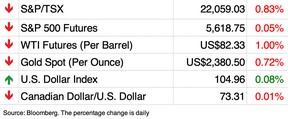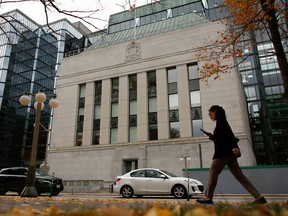There is one thing that could be a fly in the ointment on July 24
Article content

When the Bank of Canada made its first interest rate cut last month there were three risks economists cited that could stall the cycle — the Canadian dollar, the housing market and wage growth.
Douglas Porter, chief economist at BMO Capital Markets, checked in on these potential stumbling blocks on Friday in his weekly column Talking Points to determine how we were doing.
Advertisement 2
Article content
“To quote Mr. Loaf: Two out of three ain’t bad … but is it good enough,” said Porter.
The big concern around the Canadian dollar was that the Bank of Canada moving ahead of the United States Federal Reserve would cause the currency to plunge.
Yet in recent weeks the loonie has been “remarkably well behaved,” said Porter. After a soft start in the first three months of the year, the loonie appears to have found some stability at around 73.5 US cents. A weaker greenback as the U.S. economy softens and the prospect of Fed rate cuts have helped steady the currency.
Nor has the housing market flared up again as some predicted. Porter said real estate data from Canada’s major cities last week showed little pickup in activity even after the interest rate cut last month.
“The data support the initial view that it was actually sellers who stepped up, not buyers, after the bank moved,” he said.
Sales were down by the double digits in many cities from a year ago and big increases to inventories are shifting the balance in buyers’ favour.
“While sellers and the real estate industry may not like it, the reality is that a sleepy housing market may be exactly what policymakers would like to see at this point, and it also holds out the tantalizing potential of some improvement in extremely strained affordability,” he said.
Article content
Advertisement 3
Article content
However, wage growth remains a fly in the ointment. Jobs data out Friday showed that while the labour market had loosened in June, average hourly wages accelerated to 5.4 per cent.
“As a standalone result, the softening job market raises the odds of a Bank of Canada rate cut. However, wages remain the very definition of sticky, which will give the Bank pause,” said Porter in a note after the data was released.
So how much of a concern is this?
June’s pick-up in wage growth was largely due to base-effects from a low reading a year ago, said Toronto Dominion economist Marc Ercolao.
“Still, it doesn’t take away from the fact wages have been growing at around 5 per cent year-on-year for the past 18-months while productivity dipped over the same period,” he said.
Wage growth was on the governing council’s mind when it meet last month, deliberations show, but governor Tiff Macklem appeared to soften those concerns in a speech last week.
“The fact that wages are moderating more slowly than inflation is not surprising; wages tend to lag adjustments in employment,” Macklem said. “Going forward, we will be looking for wage growth to moderate further.”
Advertisement 4
Article content
Is two out of three enough, then?
After Friday’s job numbers, markets are betting on a 60 per cent probability of an interest rate cut on July 24, while a Bloomberg survey suggests the majority of economists expect a hold until Sept. 4.
And there is more data to come.
A crucial inflation reading on July 16 and the Bank of Canada’s own Business Outlook survey will still shape the central bank’s view of whether to cut or hold this month.
Sign up here to get Posthaste delivered straight to your inbox.


Canada’s unemployment rate hit 6.4 per cent in June, the highest reading since 2017, outside of the pandemic, data showed Friday.
Much of that increase came from students, whose jobless rate hit 13.5 per cent, the highest since 2014, but layoffs were also up 20 per cent from a year ago, said Nathan Janzen, assistant chief economist for Royal Bank of Canada.
The economy lost about 1,000 jobs after 2,000 part-time positions were added, but 3,000 full-time jobs were lost.

- Today’s Data: United States consumer credit



Advertisement 5
Article content
Recommended from Editorial
-

Economist ‘busts some myths’ about housing affordability
-

How Alberta is on track to become a nation-beater again

A reader with 20 years to go until retirement asks if dividend investing is a good option for him. Interest rate hikes have limited how much he can contribute to savings, and the investor wonders if it would be a better strategy to switch from growth stocks to dividends and reinvest what he earns. Financial planner Andrew Dobson has some answers. Find out more.
Are you worried about having enough for retirement? Do you need to adjust your portfolio? Are you wondering how to make ends meet? Drop us a line with your contact info and the gist of your problem and we’ll try to find some experts to help you out, while writing a Family Finance story about it (we’ll keep your name out of it, of course). If you have a simpler question, the crack team at FP Answers, led by Julie Cazzin, can give it a shot.
McLister on mortgages
Want to learn more about mortgages? Mortgage strategist Robert McLister’s Financial Post column can help navigate the complex sector, from the latest trends to financing opportunities you won’t want to miss. Plus check his mortgage rate page for Canada’s lowest national mortgage rates, updated daily.
Today’s Posthaste was written by Pamela Heaven, with additional reporting from Financial Post staff, The Canadian Press and Bloomberg.
Have a story idea, pitch, embargoed report, or a suggestion for this newsletter? Email us at posthaste@postmedia.com.
Bookmark our website and support our journalism: Don’t miss the business news you need to know — add financialpost.com to your bookmarks and sign up for our newsletters here.
Article content
Bank of Canada rate cut obstacles are fading — except for this one
2024-07-08 12:06:19





